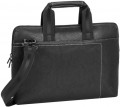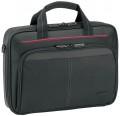Max. size
The maximum diagonal size of a laptop that can be carried in a bag. Traditionally measured in inches (''). Often the maximum size is at the same time optimal, that is, the one for which the bag was originally designed: a laptop of this size will “sit” in the mounts as tightly as possible without hanging out. At the same time, most bags allow you to transport laptops with a diagonal smaller than the maximum size — though not by much, usually by 1-2".
Now on the market, there are bags for all diagonals of laptops:
10",
11",
12",
13",
14",
15",
16",
17".
Specs
—
External compartments. The bag has external compartments. Such compartments are good because you do not need to open the main compartment of the bag to access them - thus, it is convenient to store small things and documents in them, which it is desirable to always have at hand.
-
Additional internal compartments. The bag has additional internal compartments, in addition to the compartment for the laptop itself. Such compartments can be used to store computer accessories, documents, stationery, etc. Although access to the internal compartments is more difficult than to the external ones (you need to open the bag itself), their placement provides better safety of the contents.
-
Compartment for tablet. The presence of a separate pocket in the bag, designed, as the name implies, to place a tablet PC in it. This feature allows you to transport two gadgets in one case, which can be useful, for example, on business trips or when you travel frequently.
-
Full opening. The ability of the bag to fully open, thereby decomposing like a suitcase. This solution gives comfort in packing things in a bag, and in some cases allows you to use a laptop without taking it out of the bag (case).
-
Shoulder strap. The bag has a shoulder strap. This type of transport is more convenient
...than carrying by the handle, since it leaves both hands free, and is better suited for heavy bags loaded with additional things and accessories.
- Backpack straps. Straps for carrying the bag behind the back, in fact, turning it into a backpack. True, in terms of convenience, such products still do not reach the classic backpacks; however, carrying on the back is often more convenient than carrying it by hand or over the shoulder.
— Attachment to a suitcase. For convenient and safe transportation, most modern models of bags (and sometimes covers) for laptops are equipped with a special belt (or a special through compartment) on the back side, with which the bag is securely attached to the retractable handle of a travel suitcase or luggage trolley.
- Phone pocket. The bag has a separate inner or outer pocket for carrying a mobile phone. The outer pocket is convenient because you can quickly get your phone out of it if necessary; on the other hand, there is a risk of the phone being stolen from such a pocket. In the inner pocket, the device is more protected, but it is more difficult to get to it. In general, taking into account current trends, bags with a pocket for a phone can be recommended to those who constantly carry an additional phone with them, which is inconvenient to carry in their pocket.
- USB interface. Standard USB connector located on the outside of the product. Allows you to charge smartphones, tablets and other gadgets without opening the bag - the main thing is that you have the appropriate cable at hand. Of course, for such charging, you will need to keep the laptop turned on or a power bank connected to the USB port of the bag from the inside.
— RFID protection. The presence in the bag of a pocket with electromagnetic protection against reading RFID tags. RFID technology is used, in particular, in credit cards for contactless payments; such a card works at a distance of several centimeters, and an attacker with a special scanner, getting close (for example, in a crowded transport), can read credit card data even through the fabric of a backpack. RFID protection prevents such troubles: it shields the cards inside the pocket, making them unscannable from the outside.Material
—
Cloth. Bags made of soft fabric (type unknown). Such material is inexpensive, strong enough, often made waterproof and well suited for everyday use, even in rather harsh conditions. The fabric is cleaned with a normal wash.
—
Polyester. Synthetic fibre based on polyester is characterized by good strength, resistance to moisture, ultraviolet radiation and temperature extremes, and at the same time it is relatively inexpensive. True, the specific degree of strength and durability depends on the grade of polyester: the more expensive, the more reliable the material, usually.
—
Nylon. Another type of synthetic fibre, similar in basic properties to polyester. The term "nylon" can mean different types of polymers and, accordingly, the quality of this material can also be different — from a relatively short-lived fabric that is not intended for difficult conditions, to high-end solutions like Cordura. Usually the properties of nylon are directly related to the price category of the bag.
—
Skin. Genuine leather can be called a fashion material; bags made of it look especially stylish and solid. In addition to these advantages, the skin is durable, resistant to temperature extremes and does not let water through. The disadvantages, in addition to the high price, include, first of all, the need for special care — pro
...cessing with special means, careful drying — otherwise the skin will crack and deform. In addition, leather products are prone to scratches.
— Leatherette. This is an option for those for whom genuine leather products are too expensive — leatherette can be almost indistinguishable from it in appearance, but it costs much less. In addition, care for such products is somewhat easier than for leather. On the other hand, leather substitutes are less resistant to stress, are sensitive to temperature changes, and scuffs appear on them faster. Usually, the quality (and, accordingly, the service life) of a leather substitute is directly related to its price.
— Plastic. Rigid material used in various types of bags. It has average strength characteristics, it can quite well protect the contents of the bag from impacts (although it cannot withstand strong impacts — it cracks); in addition, it is waterproof, resistant to deformations and temperature changes, and also inexpensive.
— Metal. The main advantages of metal are high strength, reliability and hardness. This material perfectly protects the equipment inside, it endures even quite strong pressures and blows without consequences. On the other hand, metal cases (usually these are cases) are not cheap, and the mentioned strength is rarely critical — simpler materials, like the same plastic, are often enough for domestic use. Therefore, this option is not particularly popular. Note also that the composition of the metal can be different. The most widely used steel and aluminium alloy; they are approximately the same in strength, while aluminium is noticeably lighter, but also more expensive than steel.
— Rubber. In this case, both rubber itself and other materials with similar properties — soft and elastic (for example, silicone) can be implied. However, these materials are predominantly used for covers (see "Type"), with some of these products designed to be permanently worn on a laptop. The softness gives the rubber some shock-resistant properties, but covers made of this material are usually designed not so much for serious protection, but rather to withstand minor household "troubles" like accidental scratches.
